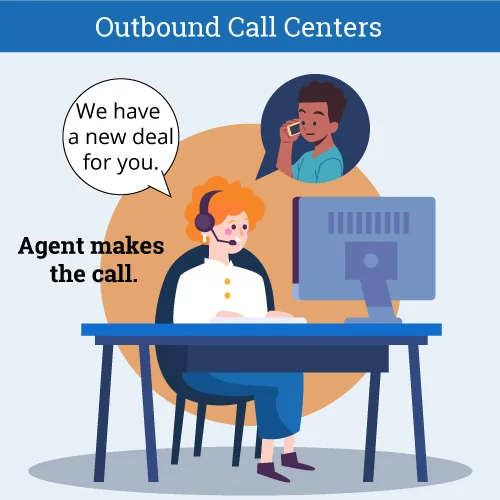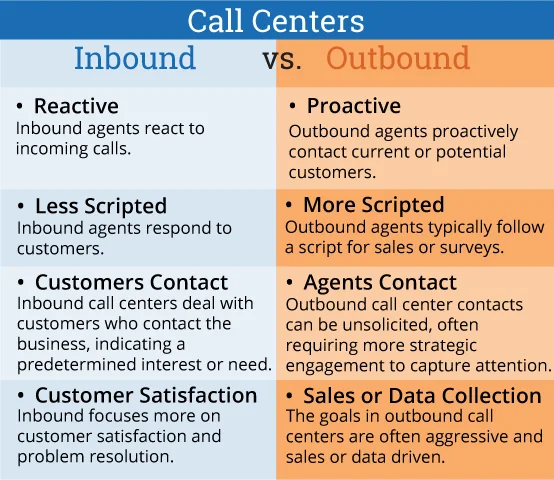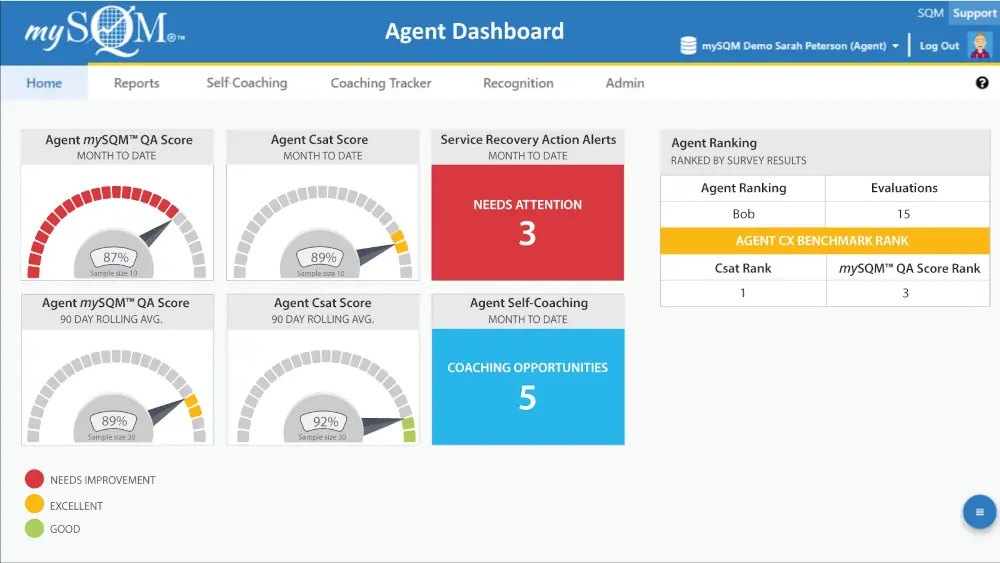Although most companies have multiple contact channels available to their customers, the most frequently used channel is still the phone. Emailing and messaging on social media might be more convenient, but at the end of the day, if a customer wants efficient and effective service, they are most likely to call a call center.
Call centers manage a high volume of both incoming and outgoing calls. Knowing the difference between inbound and outbound call centers can assist you in selecting the most suitable option for your business.
Inbound call centers are typically focused on handling incoming customer calls, ranging from product inquiries to support requests. On the other hand, outbound call centers are proactive in nature, making outgoing calls for telemarketing, lead generation, and customer surveys.
Keep reading to delve deeper into the differences between these two call center types and discover which one aligns best with your business goals.
What is an Inbound Call Center?
Inbound call centers are designed to handle incoming calls from customers. These can encompass a wide array of inquiries, including support queries, customer service requests, order processing, or helpline interactions.
The primary role of an inbound call center agent is to assist callers by identifying their needs and responding appropriately. These call centers are crucial for businesses aiming to maintain high customer satisfaction and service levels.



Here is an example of an interaction with an inbound call center:
A customer, Jane, recently noticed that her internet connection has been slower than usual. She calls the inbound call center of her internet service provider, XYZ Internet Services. When she calls, she is greeted by an automated system that guides her through a few options, and she selects "Technical Support."
A call center agent, Joe, answers the call and asks Jane to describe the problem. Jane explains that her internet speed has been very slow for the past few days. Joe accesses her account through the CRM software and performs a remote diagnostic check. He identifies that there is an issue with the configuration of Jane's modem.
Joe then walks Jane through the steps to reset her modem and update its settings. After the reset, Jane's internet speed improves significantly. Joe also provides Jane with some tips on how to maintain optimal internet speed and what to do if she encounters similar issues in the future.
Key Features of an Inbound Call Center
The effectiveness of an inbound call center hinges on several distinctive features:
- Call Routing: Efficient systems ensure calls are directed to the most suitable agent based on the query's complexity and the agent’s expertise.
- Customer Relationship Management (CRM) Integration: By integrating CRM systems, agents can access comprehensive customer histories, enabling personalized and informed service.
- Multichannel or Omnichannel Support: Modern inbound call centers leverage not only phone calls but also emails, live chats, and social media interactions to provide holistic support.
- Interactive Voice Response (IVR) Systems: These systems guide callers through a menu to help them reach the appropriate department or self-serve simple solutions.
What is an Outbound Call Center?
Unlike their inbound counterparts, outbound call centers focus on making outgoing calls to clients and prospects. These centers are pivotal for customer post-call surveys, lead generation, market research, fund-raising campaigns, and customer follow-ups.
The agents in outbound call centers aim to reach out to potential or existing customers to initiate sales, gather insights, or maintain relationships.

Here is an example of an interaction with an outbound call center:
A customer, John, recently called an insurance company, XYZ Insurance, to discuss different insurance options for his house. Later that day, SQM Group, an outbound call center company, called John to gain some insights on how his call with the insurance company went.
SQM Group asked John questions such as, “On a scale of 1 to 10, with 1 being not at all satisfied and 10 being very satisfied, how would you rate your call with XYZ Insurance?”. John answered SQM Group’s questions honestly and gave them his feedback on his recent phone interaction with XYZ Insurance.
SQM Group then gathered John’s feedback, along with many other customers’ feedback, and showed XYZ Insurance their overall customer satisfaction results. This helped XYZ Insurance make the necessary changes to improve their customer service and, in turn, increase their customer satisfaction for the future.
Key Differences from Inbound Call Centers
Outbound and inbound call centers operate in starkly different realms despite similar infrastructural setups:


- Proactive vs. Reactive: Outbound agents proactively contact potential customers, whereas inbound agents react to incoming calls.
- Script Usage: Outbound calls typically follow a script aimed at sales or data collection, making the conversation flow predetermined.
- Customer Interaction: Inbound call centers deal with customers who choose to contact the business, indicating a predetermined interest or need. In contrast, outbound call center contacts can be unsolicited, often requiring more strategic engagement to capture attention.
- Goal Orientation: The goals in outbound call centers are often aggressive and sales-driven. Inbound focuses more on customer satisfaction and problem resolution.
Why are Outbound Call Centers Important?
Outbound call centers are essential for driving business growth through direct customer engagement. Their role in sales and marketing is multifaceted:
- Customer Feedback and Improvement: Regular outbound calls help gather customer feedback, which is vital for improving products and services and adapting to market needs.
- Lead Generation: Through strategic calls, agents can generate interest and convert calls into valuable leads or sales.
- Market Expansion: Outbound calls enable businesses to reach new demographics and geographic territories without the need for physical presence.
- Information Dissemination: Outbound centers can effectively communicate important information about new products, services, or changes to existing customers.
By understanding the distinct roles and functionalities of inbound and outbound call centers, businesses can tailor their strategies to fit their specific needs. Whether managing customer relations or actively seeking new business opportunities, each type of call center provides unique advantages that are crucial to the overall success and growth of a company.
Comparing Inbound and Outbound Call Centers
Operational Variances
Inbound call centers are designed to manage incoming calls from customers. These centers often handle queries, customer support, technical assistance, and sometimes complaint resolution. The main aim is to provide instant support to enhance customer satisfaction and loyalty. Agents are trained to be empathetic, knowledgeable, and quick in solving issues.
On the other hand, outbound call centers focus on making calls to customers and potential clients. They are pivotal in performing tasks such as customer surveys, telemarketing, lead generation, or follow-ups on previous interactions. Agents are trained to be persuasive and are often guided by specific targets or quotas they need to meet, which drives a distinctly different workflow and atmosphere compared to inbound centers.
Customer Experience and Satisfaction
The nature of interaction in inbound and outbound centers inherently affects customer experience and satisfaction. Inbound call centers, by their very nature, are customer-centric. They play a crucial role in building a company’s reputation for customer care. Skilled agents can turn even a complaint call into a positive experience, reinforcing customer loyalty and trust.
Conversely, outbound call centers tend to have a different impact on customer satisfaction. Since the calls are unsolicited, they might not always be welcomed by customers, which can occasionally lead to dissatisfaction. However, when executed with careful planning, clear objectives, and courteous communication, outbound calls can effectively boost customer engagement and inform them about valuable products or services, thus opening doors to new sales opportunities.
Hybrid Call Centers
After reading this blog, you might decide that your company needs both an inbound and an outbound call center. Luckily, you don’t need to choose one or the other; you can create a hybrid call center which includes the functionality of both.
Hybrid call centers represent an evolution in the call center industry, merging the capabilities of both inbound and outbound models. This blending approach allows businesses to offer comprehensive customer service while actively engaging in outreach activities. Here, agents are equipped to handle both incoming inquiries and outgoing calls, which enhances operational flexibility and optimizes workforce utilization.
The main downside of this model is the amount of training required for agents and the increased workload for both agents and supervisors. However, companies like SQM Group, which focus on measuring and improving customer satisfaction, can help immensely with this problem.
SQM Group gathers feedback from customers through various channels, including post-call surveys, to understand their experiences and satisfaction levels. This customer feedback data is then analyzed to identify strengths and areas for improvement in customer service.
To help agents improve, SQM Group provides a mySQM™ Customer Service QA Software designed to enhance customer experience management, such as real-time feedback systems and performance dashboards. This means that your company can rely on SQM to keep track of your company’s customer satisfaction levels through outbound calls.

Request a mySQM™ Customer Service QA Demo Video
Learn about SQM's agent… CSAT prediction model, which is based on standardized metrics, AI, and regression analysis to predict customer satisfaction derived from a QA evaluation. Our CSAT prediction model provides a high statistical correlation, translating to a 95% success rate in predicting agent CSAT in most cases.
